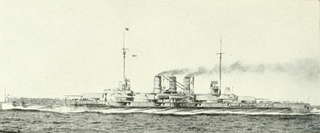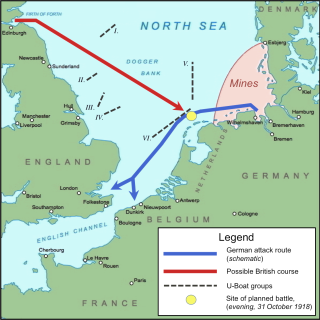
The Battle of Jutland was a naval battle fought between Britain's Royal Navy Grand Fleet, under Admiral Sir John Jellicoe, and the Imperial German Navy's High Seas Fleet, under Vice-Admiral Reinhard Scheer, during the First World War. The battle unfolded in extensive manoeuvring and three main engagements, from 31 May to 1 June 1916, off the North Sea coast of Denmark's Jutland Peninsula. It was the largest naval battle and the only full-scale clash of battleships of the war. Jutland was the third fleet action between steel battleships, following the Battle of the Yellow Sea in 1904 and the Battle of Tsushima in 1905, during the Russo-Japanese War. Jutland was the last major battle in history fought primarily by battleships.

SMS Kaiser was the lead ship of the Kaiser class of dreadnought battleships of the Imperial German Navy. Kaiser was built by the Imperial Dockyard at Kiel, launched on 22 March 1911 and commissioned on 1 August 1912. The ship was equipped with ten 30.5-centimeter (12 in) guns in five twin turrets, and had a top speed of 23.4 knots. Kaiser was assigned to III Battle Squadron of the High Seas Fleet for the majority of World War I.

HMS Benbow was the third of four Iron Duke-class battleships of the Royal Navy, the third ship to be named in honour of Admiral John Benbow. Ordered in the 1911 building programme, the ship was laid down at the William Beardmore and Company shipyard in May 1912, was launched in November 1913, and was completed in October 1914, shortly after the outbreak of the First World War. The four Iron Dukes were very similar to the preceding King George V class, with an improved secondary battery. She was armed with a main battery of ten 13.5-inch (343 mm) guns and twelve 6 in (152 mm) secondary guns. The ship was capable of a top speed of 21.25 knots, and had a 12-inch (305 mm) thick armoured belt.

SMS Bayern was the lead ship of the Bayern class of dreadnought battleships in the German Kaiserliche Marine. The vessel was launched in February 1915 and entered service in July 1916, too late to take part in the Battle of Jutland. Her main armament consisted of eight 38 cm (15 in) guns in four turrets, which was a significant improvement over the preceding König's ten 30.5 cm (12 inch) guns. The ship was to have formed the nucleus for a fourth battle squadron in the High Seas Fleet, along with three of her sister ships. Of the other ships only one—Baden—was completed; the other two were canceled later in the war when production requirements shifted to U-boat construction.

The Second Battle of Heligoland Bight, also the Action in the Helgoland Bight and the Zweite Seeschlacht bei Helgoland, was an inconclusive naval engagement fought between British and German squadrons on 17 November 1917 during the First World War.

SMS König was the first of four König-class dreadnought battleships of the Imperial German Navy during World War I. König was named in honor of King William II of Württemberg. Laid down in October 1911, the ship was launched on 1 March 1913. The construction of König was completed shortly after the outbreak of World War I; she was commissioned into the High Seas Fleet on 9 August 1914.

SMS Nassau was the first dreadnought battleship built for the Imperial German Navy, a response to the launching of the British battleship HMS Dreadnought. Nassau was laid down on 22 July 1907 at the Kaiserliche Werft in Wilhelmshaven, and launched less than a year later on 7 March 1908, approximately 25 months after Dreadnought. She was the lead ship of her class of four battleships, which included Posen, Rheinland, and Westfalen.

SMS Kronprinz was the last dreadnought battleship of the four-ship König class of the German Imperial Navy. The battleship was laid down in November 1911 and launched on 21 February 1914. She was formally commissioned into the Imperial Navy on 8 November 1914, just over 3 months after the start of World War I. The name Kronprinz refers to Crown Prince Wilhelm, and in June 1918, the ship was renamed Kronprinz Wilhelm in his honor. The battleship was armed with ten 30.5-centimeter (12.0 in) guns in five twin turrets and could steam at a top speed of 21 knots.

The König class was a group of four dreadnought battleships built for the German Kaiserliche Marine in the early 1910s. The class comprised König, the lead ship, Grosser Kurfürst, Markgraf, and Kronprinz. The design for the ships was derived from the preceding Kaiser class, using the same basic hull but with a rearranged main battery of ten 30.5 cm (12 in) guns in five twin-gun turrets to improve the guns' firing arcs. Instead of the staggered wing turrets used in the Kaisers, the Königs placed their main guns all on the centerline using superfiring pairs fore and aft. Budgetary constraints and the need to begin construction quickly to compete with Britain in the Anglo-German naval arms race prevented any more radical changes. Diesel engines were planned for the ships, but they could not be readied in time, so all four vessels reverted to steam turbines for their propulsion system.

Naval warfare in the Mediterranean during World War I took place between the naval forces of the Entente and the Central Powers in the Mediterranean Sea between 1914 and 1918.

SMS Westfalen was one of the Nassau-class battleships, the first four dreadnoughts built for the German Imperial Navy. Westfalen was laid down at AG Weser in Bremen on 12 August 1907, launched nearly a year later on 1 July 1908, and commissioned into the High Seas Fleet on 16 November 1909. The ship was equipped with a main battery of twelve 28 cm (11 in) guns in six twin turrets in an unusual hexagonal arrangement.

The Action of 22 September 1914 was an attack by the German U-boat U-9 that took place during the First World War. Three obsolete Royal Navy cruisers, of the 7th Cruiser Squadron, manned mainly by Royal Naval Reserve part-time reservists and sometimes referred to as the Live Bait Squadron, were sunk by U-9 while patrolling the southern North Sea.

The action of 19 August 1916 was one of two attempts in 1916 by the German High Seas Fleet to engage elements of the British Grand Fleet, following the mixed results of the Battle of Jutland, during the First World War. The lesson of Jutland for Germany had been the vital need for reconnaissance, to avoid the unexpected arrival of the Grand Fleet during a raid. Four Zeppelins were sent to scout the North Sea between Scotland and Norway for signs of British ships and four more scouted immediately ahead of German ships. Twenty-four German submarines kept watch off the English coast, in the southern North Sea and off the Dogger Bank.

SMS Markgraf was the third dreadnought battleship of the four-ship König class. She served in the Imperial German Navy during World War I. The battleship was laid down in November 1911 and launched on 4 June 1913. She was formally commissioned into the Imperial Navy on 1 October 1914, just over two months after the outbreak of war in Europe. Markgraf was armed with ten 30.5-centimeter (12.0 in) guns in five twin turrets and could steam at a top speed of 21 knots. Markgraf was named in honor of the royal family of Baden. The name Markgraf is a rank of German nobility and is equivalent to the English Margrave, or Marquess.

SMS Grosser Kurfürst was the second dreadnought battleship of the four-ship König class. Grosser Kurfürst served in the Imperial German Navy during World War I. The battleship was laid down in October 1911 and launched on 5 May 1913. She was formally commissioned into the Imperial Navy on 30 July 1914, days before the outbreak of war between Germany and the United Kingdom. Her name means Great Elector, and refers to Frederick William I, the Prince-elector of Brandenburg. Grosser Kurfürst was armed with ten 30.5-centimeter (12.0 in) guns in five twin turrets and could steam at a top speed of 21 knots.

SMS Friedrich der Grosse was the second vessel of the Kaiser class of dreadnought battleships of the German Imperial Navy. Friedrich der Grosse's keel was laid on 26 January 1910 at the AG Vulcan dockyard in Hamburg, her hull was launched on 10 June 1911, and she was commissioned into the fleet on 15 October 1912. The ship was equipped with ten 30.5-centimeter (12 in) guns in five twin turrets, and had a top speed of 23.4 knots. Friedrich der Grosse was assigned to III Battle Squadron of the High Seas Fleet for the majority of World War I, and served as fleet flagship from her commissioning until 1917.

SMS Oldenburg was the fourth vessel of the Helgoland class of dreadnought battleships of the Imperial German Navy. Oldenburg's keel was laid in March 1909 at the Schichau-Werke dockyard in Danzig. She was launched on 30 June 1910 and was commissioned into the fleet on 1 May 1912. The ship was equipped with twelve 30.5 cm (12 in) guns in six twin turrets, and had a top speed of 21.2 knots. Oldenburg was assigned to I Battle Squadron of the High Seas Fleet for the majority of her career, including World War I.

SMS Thüringen was the third vessel of the Helgoland class of dreadnought battleships of the German Kaiserliche Marine (Imperial Navy}. Thüringen's keel was laid in November 1908 at the AG Weser dockyard in Bremen. She was launched on 27 November 1909 and commissioned into the fleet on 1 July 1911. The ship was equipped with twelve 30.5 cm guns in six twin turrets, and had a top speed of 21 knots. Thüringen was assigned to I Battle Squadron of the High Seas Fleet for the majority of her career, including World War I.

The High Seas Fleet (Hochseeflotte) was the battle fleet of the German Imperial Navy and saw action during the First World War. The formation was created in February 1907, when the Home Fleet (Heimatflotte) was renamed as the High Seas Fleet. Admiral Alfred von Tirpitz was the architect of the fleet; he envisioned a force powerful enough to challenge the Royal Navy's predominance. Kaiser Wilhelm II, the German Emperor, championed the fleet as the instrument by which he would seize overseas possessions and make Germany a global power. By concentrating a powerful battle fleet in the North Sea while the Royal Navy was required to disperse its forces around the British Empire, Tirpitz believed Germany could achieve a balance of force that could seriously damage British naval hegemony. This was the heart of Tirpitz's "Risk Theory", which held that Britain would not challenge Germany if the latter's fleet posed such a significant threat to its own.

The naval order of 24 October 1918 was a plan made by the German Admiralty at the end of World War I to provoke a decisive battle between the German High Seas Fleet and the British Grand Fleet in the southern North Sea. When the order to prepare for the sortie was issued on 29 October, mutiny broke out aboard the German ships. Despite the operation being cancelled, these in turn led to the more serious Kiel mutiny, which was the starting point of the November Revolution and the proclamation of the Weimar Republic.


















